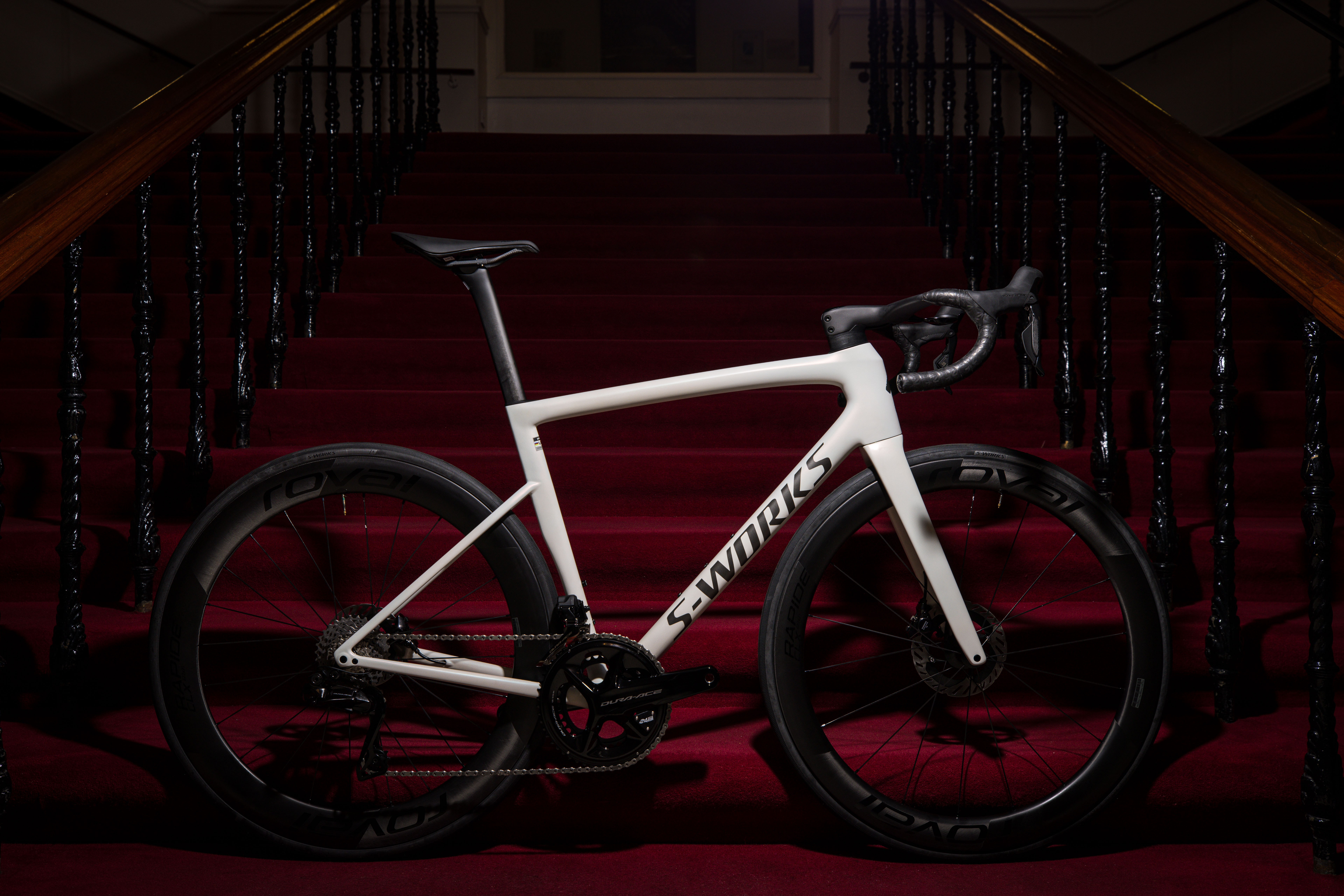
In what is one of the most highly-anticipated launches of the year, Specialized has today unveiled the latest iteration of its flagship race bike, the Tarmac, with the launch of the Tarmac SL8.
What's more, in a totally-uncoincidental twist, after remaining under wraps at the recent Tours de France, the new Tarmac also breaks cover today at the World Championships beneath Remco Evenepoel, Julian Alaphilippe and various other Specialized-sponsored athletes.
After a series of leaked documents, some of which so significant that Specialized was forced to respond, the new Tarmac is finally now officially 'out there,' and it is accompanied by a series of marketing claims that, even by Specialized's own standards, are incredibly lofty.
The brand not only says the bike is the "lightest on the WorldTour" with a frame weight of 685g, but the "world's fastest race bike" too. That's alongside a reported increase of 33% in stiffness to weight, and a 6% bump in compliance when compared to the outgoing Tarmac SL7. It would appear that Specialized is pretty proud of itself with this one.
The brand claims the bike will save 16.6 seconds over a 40km time trial when compared to the SL7, and in a couple of comically specific examples, 20 seconds over the Col du Tourmalet or 128 seconds over the 294km course of Milan-San Remo.
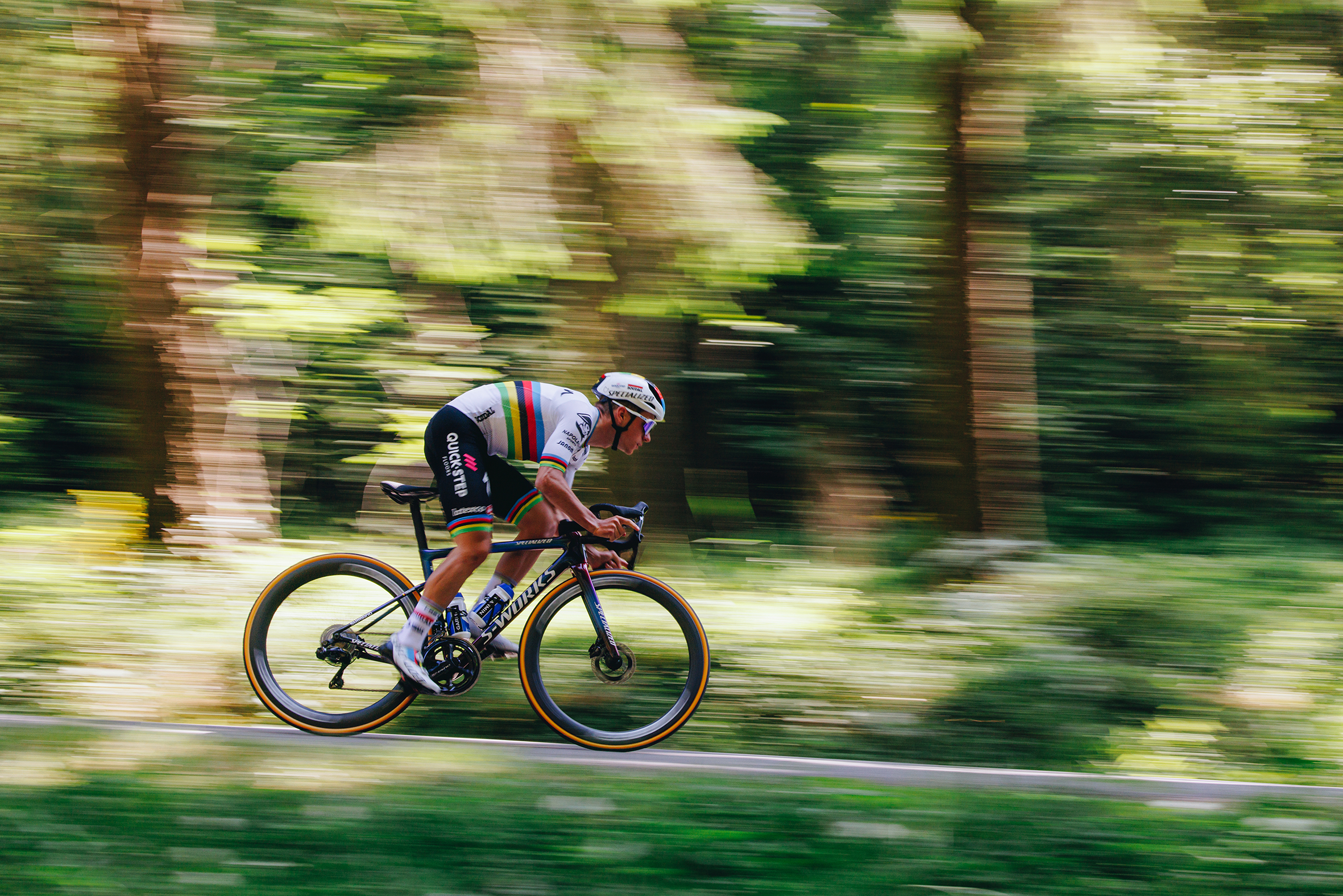
"It eclipses the 2020 Venge as the most aerodynamic road bike we’ve ever made, the chassis [frame, fork and seatpost and cockpit] is over 200g lighter than SL7, and it improves upon the same handling characteristics from the tried-and-true Tarmac," the brand boasted in its press release.
To get there, Specialized says it focussed on "aero where it actually matters," opting instead to save weight “where aerodynamics matters less or not at all." That approach led to an increased aero focus on the front end, where the head tube has gained a new forward-protruding nose cone (called the… uh.. Speed Sniffer), and the two-piece bar and stem are replaced by the recently-launched Rapide cockpit. Meanwhile, at the rear, engineers took learnings gained during the development of the lightweight Aethos to reduce weight and improve compliance.
In detail: what's new?
There's a lot to unpack here. The silhouette of the Tarmac SL8 is still unmistakably Tarmac. The DNA from the previous edition is certainly still evident, but in an ‘evolution, not revolution,’ there are numerous tweaks and updates to go through, covering the aero claims, the weight savings, and the increased stiffness and compliance.

Faster, lighter, stiffer and smoother
In order to get that full-house on bike launch buzzword bingo, Specialized says it began with a new 'equation for speed,' which essentially set out the targets for the project. It wanted the aerodynamics to be better than or equal to the Venge, the weight to be 6.8kg ready to ride, and the stiffness to be greater than or equal to the SL7.
With the focus on "aero where it matters, not where it looks good," attention was paid predominantly to the front of the bike.
"Through time spent in CFD and our Win Tunnel, the team determined the front of the bike, where airflow is more laminar, matters most when chasing a low CdA," Specialized said.
The UCI rules on frame tube profiles were relaxed at the start of 2023, and it appears Specialized has taken advantage with the head tube shape. However, instead of increasing the depth backwards by filling in the triangle behind with a bigger fairing, as the unreleased BMC aero bike has done, the Tarmac SL8 grew forwards, adding a nose cone to the front face of the head tube, similar to that of the Cannondale SystemSix.
"The biggest learning from the first phase of system optimization R&D was that a nose cone was necessary to hit our aerodynamic targets," the brand said.
That nose cone, which adds 25g and is affectionately known as the Speed Sniffer, was broadly criticised when photos leaked online with its aesthetic scolded by commenters.
But alongside a decision to move the steerer tube rearward, Specialized says it meant the leading edge of the head tube could be sharper and deliver a lower drag shape. The steerer tube inside remains at a standard 1 1/8" round profile, and so riders will be able to swap in aftermarket cockpits should they wish, although as Road Product Manager Miles Hubbard explains, this will negate some of the optimisation related to the spacer shaping and cable routing, which were both designed with the Rapide cockpit and Tarmac Stem respectively.
That's assuming they'll want to forego the new Roval Rapide cockpit, which comes fitted to S-Works builds (not included on framesets alone). This is the same one-piece bar-stem combo which launched in June, itself claiming a four-watt aero increase and a 50-gram saving.
Hubbard also admits that the cockpit provides "more than half" of the SL8's total aerodynamic improvement, and admits that some of the gain will be compromised with the inclusion of an out-front computer mount.

Kasper Asgreen would disagree with Specialized's claim that the SL8 is "lighter than anything on the WorldTour," given he rode Specialized's own super-light Aethos at the Tour de France a couple of years back, but that example was an anomaly rather than a regular occurrence so we’ll let it slide.
At a claimed 685g for a 56cm frame, it's certainly among the lightest around, 115g lighter than the outgoing SL7. Even the recent specifically-lightweight Factor O2 VAM is heavier at a claimed 730g, albeit that could be offset when taking into account that bike’s integrated seatpost.
To hit the weight target of "6.8kg ready to ride", engineers leveraged even more wind tunnel time, as well as knowledge gleaned from the development of the Aethos.
Going back to that quote of "aero only where it matters," the brand looked to the rear of the bike for its weight savings, claiming that "dropped seat stays and a narrow seatpost/seat tube are the other areas that move the needle in terms of aero performance," but that due to the turbulent air caused by the movement of the rider's legs, "the benefit of a deep section airfoil at the seat post is negligible."
As a result, the new Tarmac SL8 seat tube is narrower and shallower than before, with nearby tube profiles seeing simplified shapes to decrease weight and increase comfort.
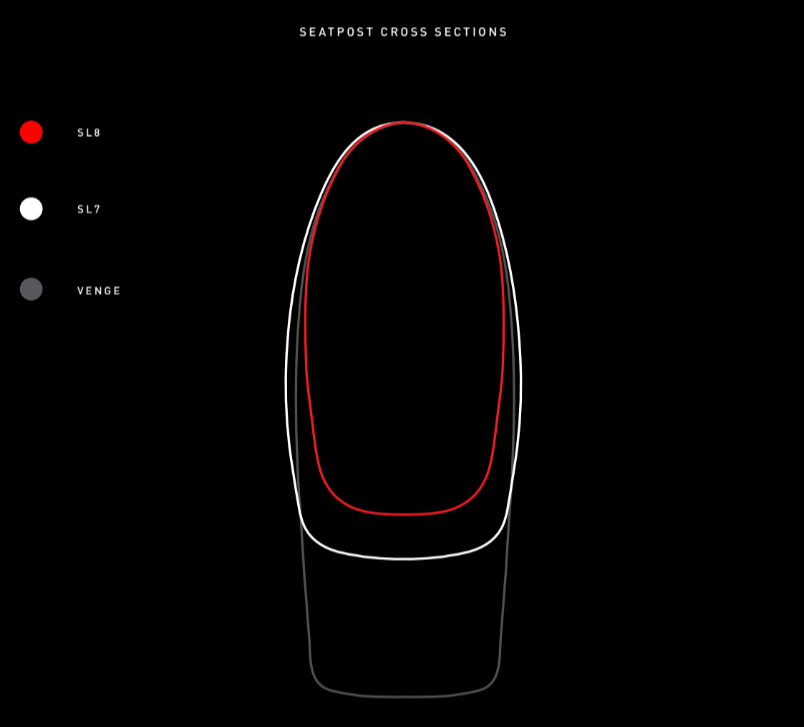
The seatpost is now so narrow, in fact, that a Shimano Di2 battery needs to be mounted beneath it, rather than inside, and the junction box housing for Di2 groupsets has also been removed. Based on the above outlines, it appears approximately 10% shallower than the SL7, and Specialized says this has led to 6% greater fore/aft compliance without any loss in lateral stiffness.
In all the frame tubes, engineers performed a "ply-by-ply analysis" during 55 iterations of carbon fibre layup to ensure all material used was "contributing to the frame's stiffness, aerodynamics, and strength."
The S-Works frame uses the same Fact 12R carbon found on the SL7, whereas the Pro and Expert models use Fact 10R carbon at a weight penalty of approximately 100g depending on size. All bikes get the same geometry, handling and aerodynamic silhouette.
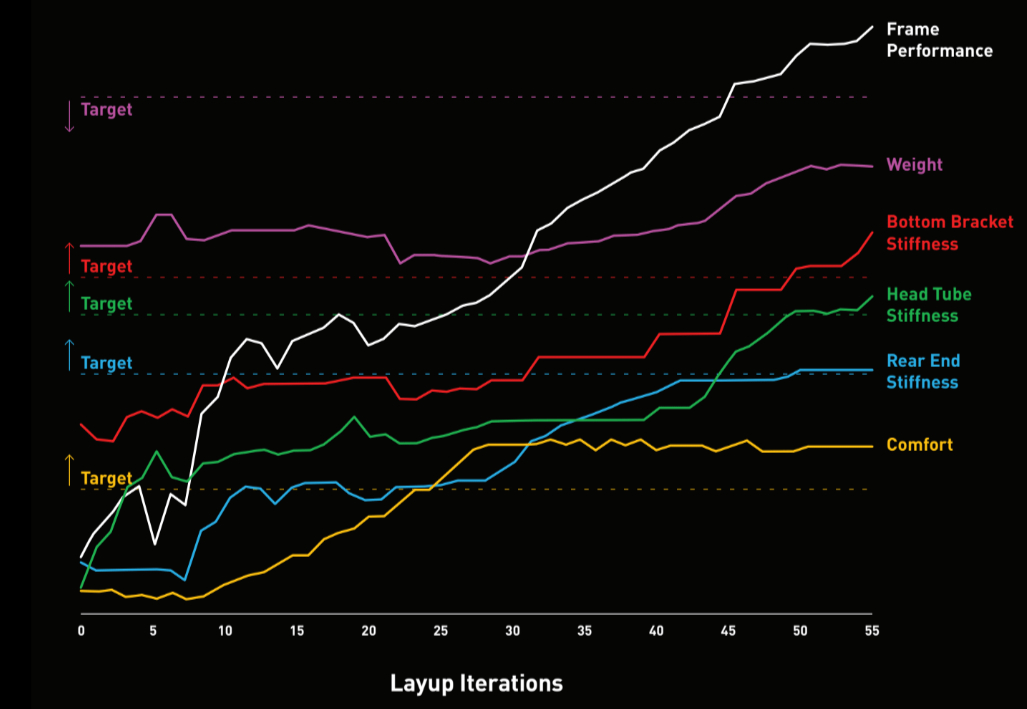
Moving on to the final area of that earlier equation, stiffness, and Specialized claims it has maintained the Tarmac's "telepathic handling" and beaten all of its predetermined stiffness targets.
It says the SL8 is more compliant than the SL7, while also returning higher stiffness numbers at the bottom bracket, front end and rear end.
It claims to have increased the stiffness to weight ratio by 33%, something with Marketing manager Ben Edwards describes as "huge, it will never happen again."
What hasn’t changed?
Like its predecessor the SL7, the S-Works Tarmac SL8 will also use Specialized's Fact 12R carbon fibre. The Pro and Expert editions beneath it in the range will use Fact 10R carbon, with a weight penalty of approximately 100g depending on size.
It will also retain the same 32mm tyre clearance, and all builds will come with 26c tyres.
Despite the repositioned steerer tube, the cable routing of the head tube remains the same, entering the head tube in front of the steerer tube after travelling on the underside of the stem. Even with the one-piece Rapide cockpit, the cables exit beneath the stem before entering via an adapted upper headset cover.
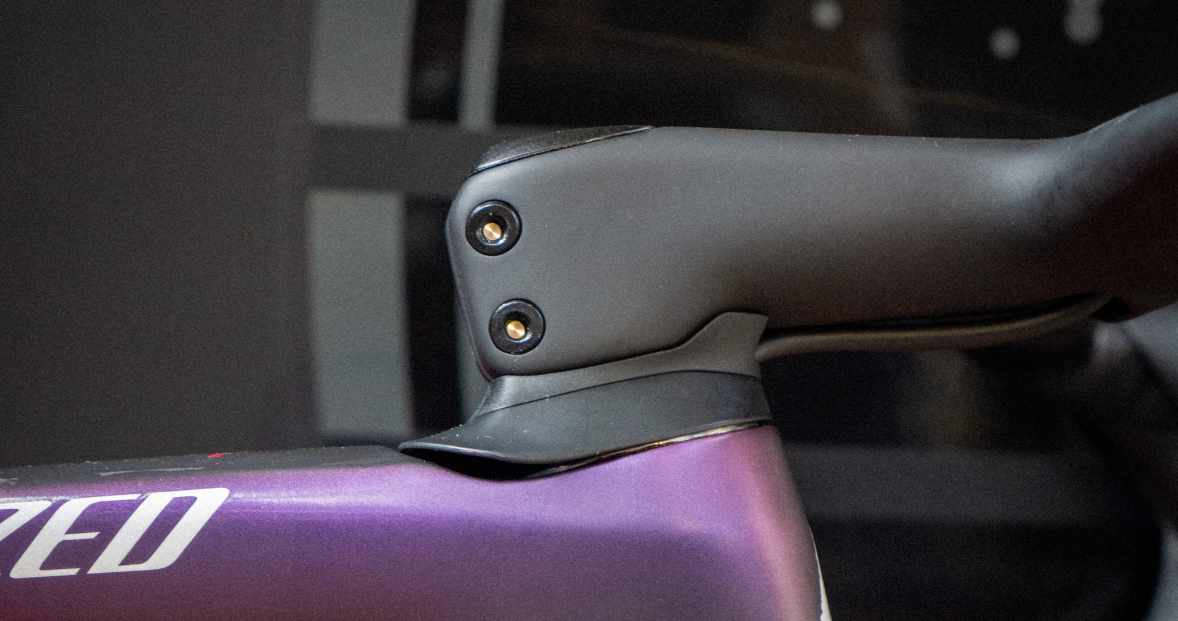
The geometry remains unchanged too, with the stack and reach numbers (when measured to the stem) mimicking those of the outgoing SL7. Stack and reach numbers to the frame will show a slight difference due to the indentation at the top of the head tube as shown in the image above.
Sizing options are also unchanged, with all models available from 44cm to 61cm. Specialized makes a point of highlighting its Beyond Gender philosophy which was brought to the fore with the Tarmac SL6, as well as its Rider First Engineering, which ensures the same handling and stiffness properties across all sizes.
The bottom bracket will also remain unchanged, with Specialized retaining the threaded BSA standard.
Build details and models
There will be five full-bike models available within the Tarmac SL8 range.
The hero model will feature the S-Works frame, available with a choice of SRAM Red eTap or Shimano Dura Ace Di2 groupset, complete with the Roval Rapide Cockpit and Roval Rapide CLX II wheels.
There will be two second-tier Pro models, built around the Fact 10R carbon frame with either SRAM Force eTap or Shimano Ultegra Di2 groupsets, the Tarmac stem and Roval Rapide aero handlebar as found on the SL7, as well as the second-tier Roval Rapide CL wheels.
The sole third-tier Expert model will be based around the same Fact 10R frame, with SRAM Rival eTap. There is no Shimano 105 Di2 option available. On this model, the Tarmac SL7 stem will remain, but with a round Specialized Expert alloy handlebar. Roval’s third-tier carbon fibre aero wheels, the Rapide C38, will be fitted.
Both tiers of framesets will also be available on their own, and will ship with a fork, seatpost and small parts, but will not ship with a cockpit.
All models, across both frameset levels, are compatible with electronic groupsets only. The complete builds all come with 2x groupsets and a power meter as standard. Clearance limits chainrings to a maximum of 55/42T. For riders who switch to 1x, the front derailleur hanger can be removed and Specialized will provide a cover to enable a cleaner setup when doing so. Due to the narrower Q-factor, maximum chainring size is limited to 54T.
Sizes will include 44cm, 49cm, 52cm, 54cm, 56cm, 58cm, and 61cm across all models.
All will be delivered with a -15mm offset seatpost, but an in-line post is available aftermarket.
The cockpit size will depend on frame size ordered, with stem length and bar width growing with the size based on averages from Specialized's Retul Fit data. Interestingly, on S-Works bikes, the Rapide cockpit will be inside the bike box but in its own aftermarket retail packaging too. This is done in a bid to make it easier for stores to swap stock and enable fit adjustments for riders buying complete S-Works bikes.
Full builds
Specs:
- Fact 12R frame
- SRAM Red eTap AXS
- Roval Rapide cockpit
- Roval Rapide CLX II wheelset
Weight:
- 6.85kg
Colours:
- Gloss Red Sky / Fiery Red Strata / Satin white
- Satin Fog Tint / Green Ghost Pearl
Prices:
£12,000 / $14,000 / €14,000 / AU$19,900
Specs:
- Fact 12R frame
- Shimano Dura-Ace Di2 R9250
- Roval Rapide cockpit
- Roval Rapide CLX II wheelset
Weight:
- 6.62kg
Colours:
- Satin Carbon / Viavi Cynan Blue / Viavi Silver-Blue Pearl / Gloss Metallic White Silver
- Satin Fog Tint / Green Ghost Pearl
Prices:
£12,000 / $14,000 / €14,000 / AU$19,900
Specs:
- Fact 10R frame
- SRAM Force eTap AXS
- Tarmac SL7 stem and Roval Rapide handlebar
- Roval Rapide CL II wheelset
Weight:
- 7.44kg
Colours:
- Satin Carbon / Metallic White Silver
Prices:
£8,000 / $8,500 / €8,500 / AU$11,900
Specs:
- Fact 10R frame
- Shimano Ultegra Di2 R8150
- Tarmac SL7 stem and Roval Rapide handlebar
- Roval Rapide CL II wheelset
Weight:
- 7.16kg
Colours:
- Gloss Pine Green Metallic / White
- Satin Blue Onyx / Black
Prices:
£8,000 / $8,500 / €8,500 / AU$11,900
Specs:
- Fact 10R frame
- SRAM Rival eTap AXS
- Tarmac SL7 stem and Expert Alloy handlebar
- Roval Rapide C38 wheelset
Weight:
- 7.77kg
Colours:
- Gloss Metallic Dark Navy / Astral Blue Pearl~
- Gloss Smoke / Obsidian
- Satin Powder Indigo Tint Over Silver Dust
Prices:
£6,000 / $6,500 / €6,500 / AU$9,400
Framesets
Specs:
- Fact 12R frame
Weight:
- 1.41kg (frame, fork, seatpost, small parts)
Colours:
- Gloss Carbon / Viavi Maganta Gold / Chaos Red Pearl / White
- Gloss White Dune / White Pearl / Impasto
- Satin Carbonb / Viavi Cynan Blue / Viavi Silver-Blue Pearl Edge Fade
- Satin Powder Indigo / Amber Glow Strata
- Satin Carbon / Black Tint Over Chameleon Blend
- Ready to paint
Prices:
£4,750 / $5,500 / €5,500 / AU$8,900
Specs:
- Fact 10R frame
Weight:
- 1.69kg (frame, fork, seatpost, small parts)
Colours:
- Gloss Carbon / Metallic Vivid Pink Strata / Electric Green
- Satin Blue Onyx / Black
Prices:
£3,000 / $3,500 / €4,000 / AU$5,600
Pricing - it’s cheaper!
In a surprising turn of events, in most cases, the Specialized Tarmac SL8 will be LESS EXPENSIVE than the outgoing Tarmac SL7.
That statement applies to complete builds and the Pro level frameset. The S-Works frameset does see a price hike in certain markets, with the price remaining equal in the USA.
I’ll also caveat that with the fact that I’m comparing to the current pricing of the SL7, rather than its price at launch in 2020, but even so, the fact that Specialized has chosen to reduce the price, rather than hold it steady or even increase it, is significant.
It could be a sign that we’ve reached a peak in bike pricing (though that is probably wishful thinking). At the very least, it suggests that the supply chain difficulties and associated price hikes facing the industry have eased, which is a definite positive.
The Tarmac SL8 will be available for sale immediately at launch at local dealers and at Specialized.com.







